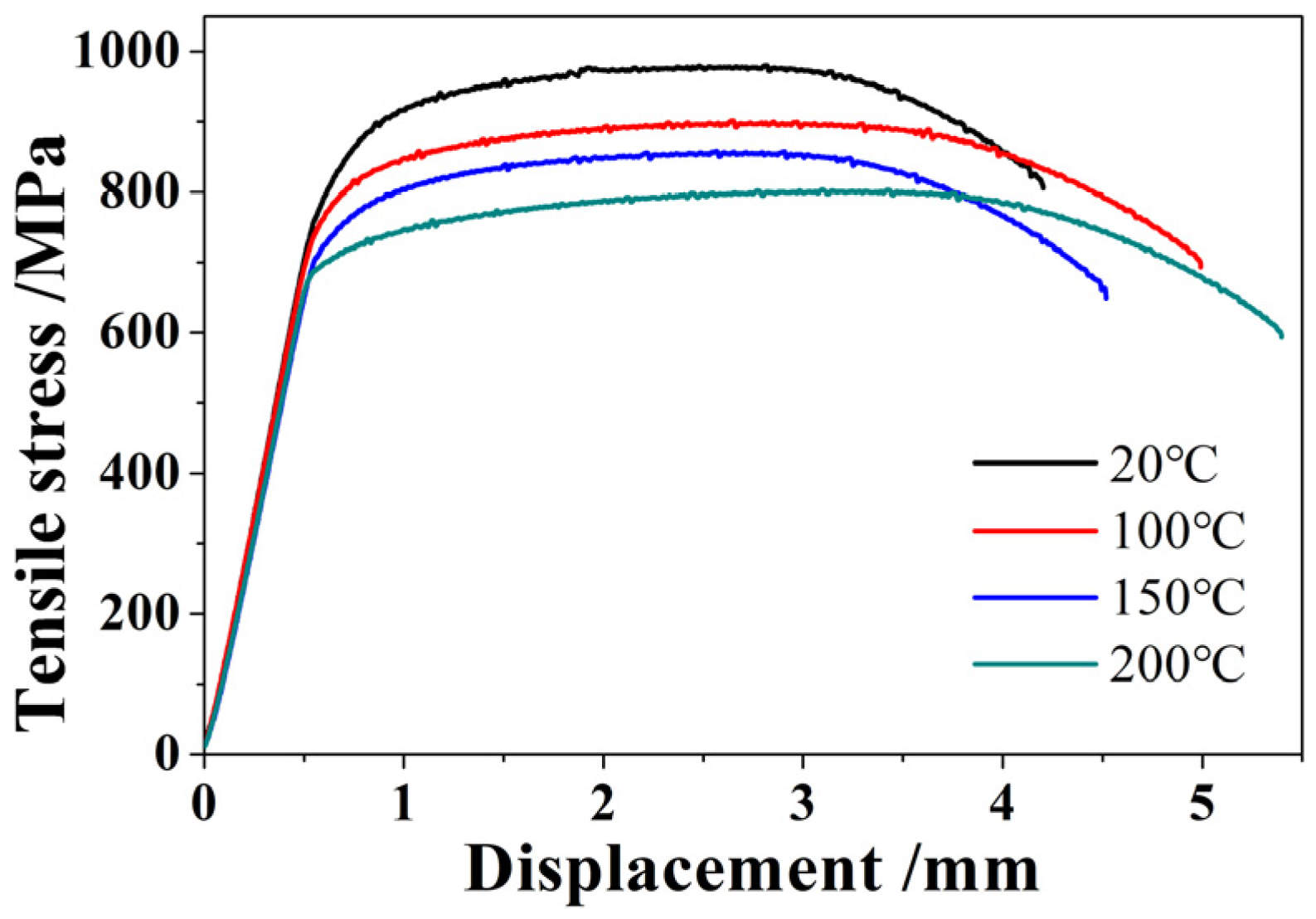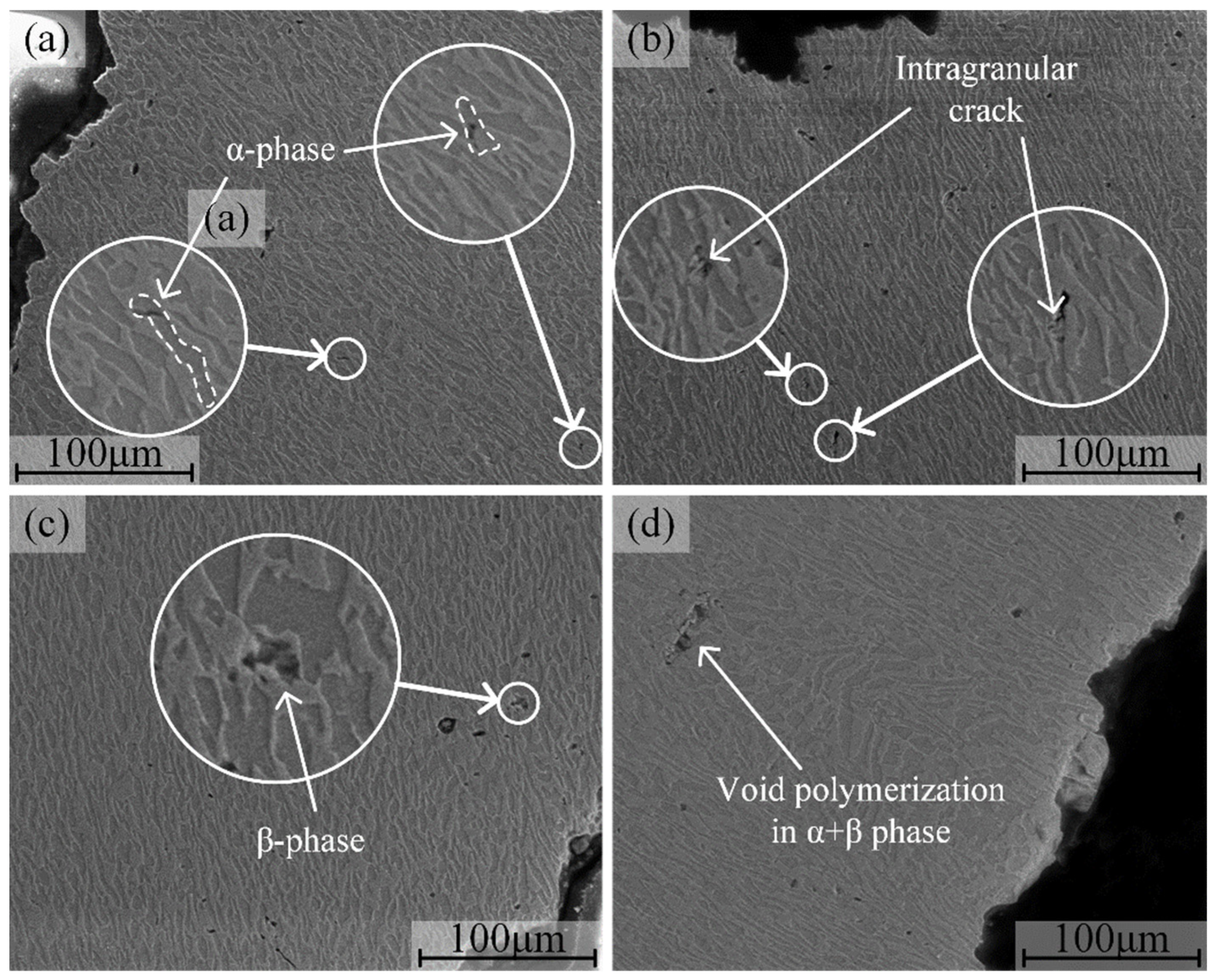β-Phase-Induced Quasi-Cleavage Fracture Mechanism by Dual-Phase High-Strength Titanium Alloy at Elevated Temperature
Abstract
1. Introduction
2. Materials and Experimental Methods
2.1. Materials and Microstructure
2.2. Experimental Method
3. Results
3.1. Tensile Strength Affected by Temperature
3.2. Fracture Analysis
4. Discussion
4.1. Fracture Mechanism of Temperature Influence
4.2. Strength Decrease Caused by Temperature
5. Conclusions
Author Contributions
Funding
Institutional Review Board Statement
Informed Consent Statement
Data Availability Statement
Conflicts of Interest
References
- Mou, Y.; Lian, Z.; Li, W.; Zhong, X.; Li, J.; He, Y.; Cao, J.; Eliaz, N. The effect of friction welding on the mechanical properties and corrosion fatigue resistance of titanium alloy drill pipe. Fatigue Fract. Eng. Mater. Struct. 2022, 45, 466–481. [Google Scholar] [CrossRef]
- Jiang, L.; Feng, C.; Liu, H.Q.; Wang, L.; Han, L.H.; Feng, Y.R.; Li, F.P.; Lu, C.H.; Zhu, L.J.; Wang, H. Deformation Stability of a Low-Cost Titanium Alloy Used for Petroleum Drilling Pipe. In Materials Science Forum; Trans Tech Publications Ltd.: Wollerau, Switzerland, 2019; pp. 887–891. [Google Scholar]
- Liu, Q.; Li, N.; Shen, Z.X.; Zhao, M.F.; Xie, J.F.; Zhu, G.C.; Xu, X.; Yin, C.X. Calculation model and experimental study of the collapse strength of titanium alloy tubing and casing. Sci. Rep. 2022, 12, 4526. [Google Scholar] [CrossRef] [PubMed]
- Mla, C.; Ml, B.; Xtw, A.; Mcl, A.; Xl, A.; Zmr, A.; Ghc, A.; Zhz, C. Effect of tempering temperature at high temperature zone on sulfide stress cracking behavior for casing steel. Eng. Fail. Anal. 2019, 105, 227–236. [Google Scholar]
- Wang, F.; Tan, X.; Wang, R.; Sun, M.; Wang, L.; Liu, J. High temperature and high pressure rheological properties of high-density water-based drilling fluids for deep wells. Petrol. Sci. 2012, 9, 354–362. [Google Scholar] [CrossRef]
- Li, D.; Hui, S.X.; Ye, W.J.; Li, C.L. Microstructure and mechanical properties of a new high-strength and high-toughness titanium alloy. Rare Met. 2016. [Google Scholar] [CrossRef]
- Boehlert, C.J.; Tamirisakandala, S.; Curtin, W.A.; Miracle, D.B. Assessment of in situ TiB whisker tensile strength and optimization of TiB-reinforced titanium alloy design. Scr. Mater. 2009, 61, 245–248. [Google Scholar] [CrossRef]
- Bodunrin, M.O.; Chown, L.H.; Merwe, J.; Alaneme, K.K.; Mphasha, N.P. Corrosion behavior of titanium alloys in acidic and saline media: Role of alloy design, passivation integrity, and electrolyte modification. Corros. Rev. 2020, 38, 25–48. [Google Scholar] [CrossRef]
- Wegner, N.; Kotzem, D.; Wessarges, Y.; Emminghaus, N.; Hoff, C.; Tenkamp, J.; Overmeyer, L.; Walther, F. Corrosion and corrosion fatigue properties of additively manufactured magnesium alloy WE43 in comparison to titanium alloy Ti-6Al-4V in physiological environment. Materials 2019, 12, 2892. [Google Scholar] [CrossRef]
- Kitashima, T.; Suresh, K.S.; Yamabe-Mitarai, Y. Effect of germanium and silicon additions on the mechanical properties of a near-α titanium alloy. Mater. Sci. Eng. A 2014, 597, 212–218. [Google Scholar] [CrossRef]
- Chen, W. Preparation of Multiscale α Phase by Heat Treatments and Its Effect on Tensile Properties in Metastable β Titanium Alloy Sheet. Metals 2021, 11, 1708. [Google Scholar]
- Long, W. Effect of Third-Stage Heat Treatments on Microstructure and Properties of Dual-Phase Titanium Alloy. Materials 2021, 14, 2776. [Google Scholar]
- Gao, J.; Knowles, A.J.; Guan, D.; Rainforth, W.M. ω phase strengthened 1.2GPa metastable β titanium alloy with high ductility. Scr. Mater. 2018, 162, 77–81. [Google Scholar] [CrossRef]
- Li, Y.; Liao, Z.; Zhang, W.; Wu, Z.; Zhou, C. Strength-Ductility Synergy in a Metastable β Titanium Alloy by Stress Induced Interfacial Twin Boundary ω Phase at Cryogenic Temperatures. Materials 2020, 13, 4732. [Google Scholar] [CrossRef] [PubMed]
- Gao, J.; Nutter, J.; Liu, X.; Guan, D.; Rainforth, W.M. Segregation mediated heterogeneous structure in a metastable β titanium alloy with a superior combination of strength and ductility. Sci. Rep. 2018, 8, 7512. [Google Scholar] [CrossRef] [PubMed]
- Chuan, W.; He, Y.; Wei, L.H. Substructure and texture evolution and flow behavior of TA15 titanium alloy compressed in the alpha + beta two-phase field. J. Mater. Process. Technol. 2013, 213, 2033–2041. [Google Scholar] [CrossRef]
- Dong, R.; Li, J.; Kou, H.; Fan, J.; Tang, B.; Sun, M. Precipitation behavior of α phase during aging treatment in a β-quenched Ti-7333. Mater. Charact. 2018, 140, 275–280. [Google Scholar] [CrossRef]
- Sordi, V.L.; Ferrante, M.; Kawasaki, M.; Langdon, T.G. Microstructure and tensile strength of grade 2 titanium processed by equal-channel angular pressing and by rolling. J. Mater. Sci. 2012, 47, 7870–7876. [Google Scholar] [CrossRef]
- Wang, L.; Lin, Z.; Wang, X.; Shi, Q.; Yin, W. Effect of Aging Treatment on Microstructure and Mechanical Properties of Ti27Nb2Ta3Zr β Titanium Alloy for Implant Applications. Mater. Trans. 2014, 55, 141–146. [Google Scholar] [CrossRef]
- Thijs, L.; Verhaeghe, F.; Craeghs, T.; Humbeeck, J.V.; Kruth, J.P. A study of the microstructural evolution during selective laser melting of Ti–6Al–4V. Acta Mater. 2010, 58, 3303–3312. [Google Scholar] [CrossRef]
- Stella, P.; Giovanetti, I.; Masi, G.; Leoni, M.; Molinari, A. Microstructure and microhardness of heat-treated Ti–6Al–2Sn–4Zr–6Mo alloy. J. Alloy. Compd. 2013, 567, 134–140. [Google Scholar] [CrossRef]
- Reguly, C.K.A.J. Effect of plastic deformation on the toughness behaviour of radial friction welds in Ti–6Al–4V–0.1Ru titanium alloy. Mater. Sci. Eng. A 2006, 417, 49–55. [Google Scholar]
- Du, Z.; Xiao, S.; Xu, L.; Jing, T.; Kong, F.; Chen, Y. Effect of heat treatment on microstructure and mechanical properties of a new β high strength titanium alloy. Mater. Des. 2014, 55, 183–190. [Google Scholar] [CrossRef]
- Zhu, S.; Yang, H.; Guo, L.G.; Fan, X.G. Effect of cooling rate on microstructure evolution during α/β heat treatment of TA15 titanium alloy. Mater. Charact. 2012, 70, 101–110. [Google Scholar] [CrossRef]
- Setti, S.G.; Rao, R.N. Tribological behaviour of near β titanium alloy as a function of α+β solution treatment temperature. Mater. Des. 2013, 50, 997–1004. [Google Scholar] [CrossRef]
- Sang, W.L.; Kim, J.H.; Chan, H.P.; Hong, J.K.; Yeom, J.T. Alloy design of metastable α+β titanium alloy with high elastic admissible strain. Mater. Sci. Eng. A 2021, 802, 140621. [Google Scholar]
- Wang, G.; Chen, Z.; Li, J.; Liu, J.; Yang, R. Microstructure and Mechanical Properties of Electron Beam Welded Titanium Alloy Ti-6246. Acta Metall. Sin. 2016, 34, 570–576. [Google Scholar] [CrossRef]
- Hurley, P.J.; Whittaker, M.T.; Webster, P.; Evans, W.J. A methodology for predicting creep/fatigue crack growth rates in Ti 6246. Int. J. Fatigue 2007, 29, 1702–1710. [Google Scholar] [CrossRef][Green Version]
- Whittaker, M.T.; Evans, W.J.; Hurley, P.J.; Flynn, D. Prediction of notched specimen behaviour at ambient and high temperatures in Ti6246. Int. J. Fatigue 2007, 29, 1716–1725. [Google Scholar] [CrossRef][Green Version]
- Zhang, Z.Q.; Dong, L.M.; Yang, Y.; Guan, S.X.; Liu, Y.Y.; Yang, R. Microstructure refinement of a dual phase titanium alloy by severe room temperature compression. Trans. Nonferrous Met. Soc. China 2012, 22, 2604–2608. [Google Scholar] [CrossRef]
- Chen, Y.; Yang, C.; Fan, C.; Zhuo, Y.; Chen, C. Grain refinement of additive manufactured Ti-6.5Al-3.5Mo-1.5Zr-0.3Si titanium alloy by the addition of La2O3. Mater. Lett. 2020, 275, 128170. [Google Scholar] [CrossRef]
- Ding, C.; Liu, C.; Zhang, L.; Deng, Y.; Liu, H.; Wu, D.; Liu, L. Microstructure and tensile properties of a cost-affordable and ultrahigh-strength metastable β titanium alloy with a composition of Ti-6Al-1Mo-1Fe-6.9Cr. J. Alloy. Compd. 2022, 901, 163476. [Google Scholar] [CrossRef]
- Liu, F.; Chen, Y.; He, C.; Li, L.; Liu, Y. Tensile and very high cycle fatigue behaviors of a compressor blade titanium alloy at room and high temperatures. Mater. Sci. Eng. A 2021, 811, 141049. [Google Scholar] [CrossRef]
- Wei, W.; Feng, Y.; Han, L.; Zhang, Q.; Zhang, J. Cyclic hardening and dynamic strain aging during low-cycle fatigue of Cr-Mo tempered martensitic steel at elevated temperatures. Mater. Sci. Eng. A 2018, 734, 20–26. [Google Scholar] [CrossRef]
- Lü, Z.; Zhang, C.J.; Du, Z.X.; Han, J.C.; Zhang, S.Z.; Yang, F.; Chen, Y.Y. Relationship between microstructure and tensile properties on a near-β titanium alloy after multidirectional forging and heat treatment. Rare Met. 2019, 38, 7. [Google Scholar] [CrossRef]








| Ti | Cr | Mo | Zr | Al | Fe | C |
|---|---|---|---|---|---|---|
| 88.3 | 3.3 | 3.5 | 0.6 | 4.3 | 0.02 | 0.03 |
Publisher’s Note: MDPI stays neutral with regard to jurisdictional claims in published maps and institutional affiliations. |
© 2022 by the authors. Licensee MDPI, Basel, Switzerland. This article is an open access article distributed under the terms and conditions of the Creative Commons Attribution (CC BY) license (https://creativecommons.org/licenses/by/4.0/).
Share and Cite
Wei, W.; Qu, H.; Cheng, J.; Zhang, R.; Cao, Y.; Cui, L. β-Phase-Induced Quasi-Cleavage Fracture Mechanism by Dual-Phase High-Strength Titanium Alloy at Elevated Temperature. Crystals 2022, 12, 1255. https://doi.org/10.3390/cryst12091255
Wei W, Qu H, Cheng J, Zhang R, Cao Y, Cui L. β-Phase-Induced Quasi-Cleavage Fracture Mechanism by Dual-Phase High-Strength Titanium Alloy at Elevated Temperature. Crystals. 2022; 12(9):1255. https://doi.org/10.3390/cryst12091255
Chicago/Turabian StyleWei, Wenlan, Hao Qu, Jiarui Cheng, Rui Zhang, Yinping Cao, and Lu Cui. 2022. "β-Phase-Induced Quasi-Cleavage Fracture Mechanism by Dual-Phase High-Strength Titanium Alloy at Elevated Temperature" Crystals 12, no. 9: 1255. https://doi.org/10.3390/cryst12091255
APA StyleWei, W., Qu, H., Cheng, J., Zhang, R., Cao, Y., & Cui, L. (2022). β-Phase-Induced Quasi-Cleavage Fracture Mechanism by Dual-Phase High-Strength Titanium Alloy at Elevated Temperature. Crystals, 12(9), 1255. https://doi.org/10.3390/cryst12091255






